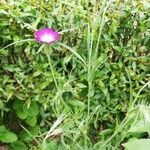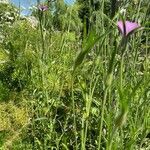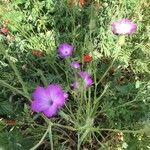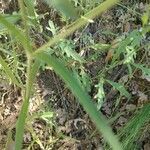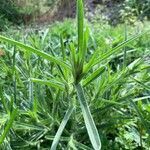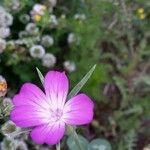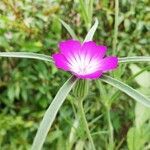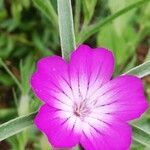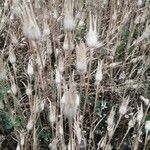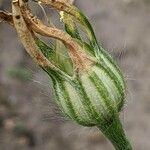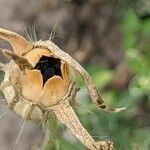Herb, annual, with long, white or greyish, appressed hairs. Stems erect, sparsely-branched, 30–100 cm high. Leaves subsessile, slightly connate, linear-lanceolate, acute, 5–12 cm long, 3–15 mm wide. Inflorescence 1–few-flowered; bracts herbaceous. Pedicels to 10 cm long. Calyx cylindrical-ovoid, 3–5 cm long, woolly; calyx lobes linear, spreading, leaf-like, often caducous. Petals shorter than calyx lobes, crimson or dull purple, not spotted, entire or subemarginate. Styles 5. Capsule ovoid, c. 25 mm long, exceeding calyx tube. Seeds 3–3.5 mm wide, black, echinulate-tuberculate.
An annual herb. It grows about 1 m high and spreads about 40-100 cm wide. There is a shallow taproot. The stem is slender, hairy and with few branches. The leaves are in opposite pairs. They are narrow and 12 cm long. They are covered with fine white silky hairs. Leaves are grey-green. The flowers are dull purple. They occur singly on long stalks in the axils of leaves. The flowers have 5 petals. These are 2.5-6 cm wide and have distinct veins. The sepals are long narrow and green. The fruit is a large oval capsule containing seeds.
Stem to 1 m, thinly hairy; lvs linear or lanceolate, 8–12 cm × 5–10 mm; fls reddish, solitary at the ends of the branches, on pedicels to 2 dm; cal-tube 12–18 mm, elliptic-ovoid, the lobes 2–4 cm, lance-linear, acute or acuminate; pet 2–3 cm, oblanceolate, retuse; fr 14–18 mm; 2n=48. Native of Europe, widely established as a weed of grainfields and waste places, most abundant in the n. part of our range. July–Sept.
Like A. githago, but calyx-tube narrower and less hairy; petal-limb usually greenish-spotted; seeds mostly less than 3 mm, with smaller, obtuse tubercles, or almost smooth.
